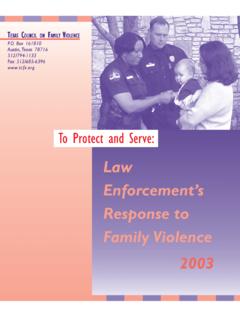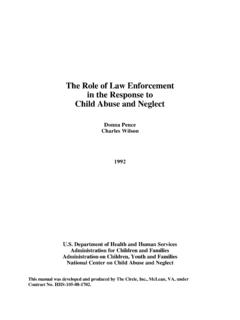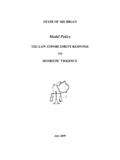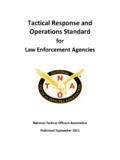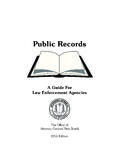Transcription of LAW-ENFORCEMENT POLICY AND PROCEDURES …
1 LAW-ENFORCEMENT POLICY AND PROCEDURES FOR REPORTS OF MISSING AND ABDUCTED CHILDREN A MODEL Developed by The National Center for Missing & Exploited Children Revised October 2011 This project was supported by Grant No. 2011-MC-CX-K001 awarded by the Office of Juvenile Justice and Delinquency Prevention, Office of Justice Programs, Department of Justice. This document is provided for informational purposes only and does not constitute legal advice or professional opinion on specific facts.
2 Information provided in this document may not remain current or accurate, so recipients should use this document only as a starting point for their own independent research and analysis. If legal advice or other expert assistance is required, the services of a competent professional should be sought. Points of view or opinions in this document are those of the author and do not necessarily represent the official position or policies of the Department of Justice. National Center for Missing & Exploited Children and 1-800-THE-LOST are registered trademarks of the National Center for Missing & Exploited Children.
3 I The National Center for Missing & Exploited Children Model LAW-ENFORCEMENT POLICY and PROCEDURES for Reports of Missing and Abducted Children Overview Reports of missing children can be among the most challenging, and emotionally charged cases a LAW-ENFORCEMENT agency will ever experience. The attitude and approach an agency and its officers take in responding to reports of missing children may very well determine whether the child is recovered promptly and safely or remains missing for months or years or, even worse, is never recovered.
4 Each stage of the case, therefore, from initial investigation through successful recovery, forms a critical component of a thorough LAW-ENFORCEMENT response. A LAW-ENFORCEMENT agency must provide its officers with the tools enabling them to act decisively when confronted with reports of missing children. The single, most important tool an agency can provide is a clearly worded POLICY directive containing understandable PROCEDURES for officers to follow as a guide through each stage of the investigation. Policies and PROCEDURES are of limited value, however, unless an agency ensures every member receives direct instruction about the POLICY s intent.
5 Additionally, specific training and awareness about the overall issue of missing children will help each officer understand the critical role he or she plays in this important area of child protection. For example officers should be aware they might encounter several types of missing-child cases, each with their own unique response requirements. They include the types of cases noted below. A. Nonfamily abduction involves a child who has been wrongfully taken by a nonfamily perpetrator through the use of physical force, persuasion, or threat of bodily harm.
6 B. Family abduction occurs when, in violation of a court order, a decree, or other legitimate custodial rights, a member of the child s family, or someone acting on behalf of a family member, takes or fails to return a child. This is also referred to as parental kidnapping and custodial interference. C. A Runaway child, often a teenager, leaves home voluntarily for a variety of reasons. This would include any child 17 years of age or younger. D. The Thrownaway is a child whose caretaker makes no effort to recover the child after running away, who has been abandoned or deserted, or who has been asked to leave his or her home and not allowed to return.
7 While not necessarily reported to authorities as missing, children in this category frequently come to the attention of law enforcement . E. The Lost, Injured, or Otherwise Missing child is defined as a child who has disappeared under unknown circumstances. The incident may range from the child wandering away and becoming lost to the child being abducted, wherein no one witnessed the act. These circumstances sometimes involve foul play, where those reporting the incident are attempting to cover-up a crime involving the child.
8 It should be noted not all missing-child incidents occurring each year in this country result in a direct LAW-ENFORCEMENT response. Some incidents are resolved by parents, relatives, friends, or ii neighbors while others are over ( , the child escapes or returns home) before law enforcement is notified. This discussion should point out to the LAW-ENFORCEMENT administrator that law enforcement is usually called upon to handle the most demanding missing-child reports those cases requiring decisive action and a carefully planned response.
9 When developing POLICY and PROCEDURES regarding missing-children cases, it is essential each response, regardless of what the initial indicators may be, should be governed by an assumption the child is in jeopardy until significant facts to the contrary are confirmed. When officers respond with the missing child s safety as their foremost concern, they will be more likely to collect evidence or information that might otherwise be lost during the critical, early stages of an investigation. Using the Model POLICY This model POLICY about missing children has been designed to serve as a general reference and may be modified to fit the specific needs of any agency, regardless of size.
10 It attempts to present the missing-child-response process in a logical progression from case intake through first response and case investigation on to recovery and case closure. From the basic outline presented in this model, administrators are encouraged to add those topics unique to their agency or region of the country and incorporate actions mandated by statutes at all levels from federal to local. It should also be noted the text found in italics is offered as explanation, and its inclusion in an agency s final POLICY or PROCEDURES is optional.
